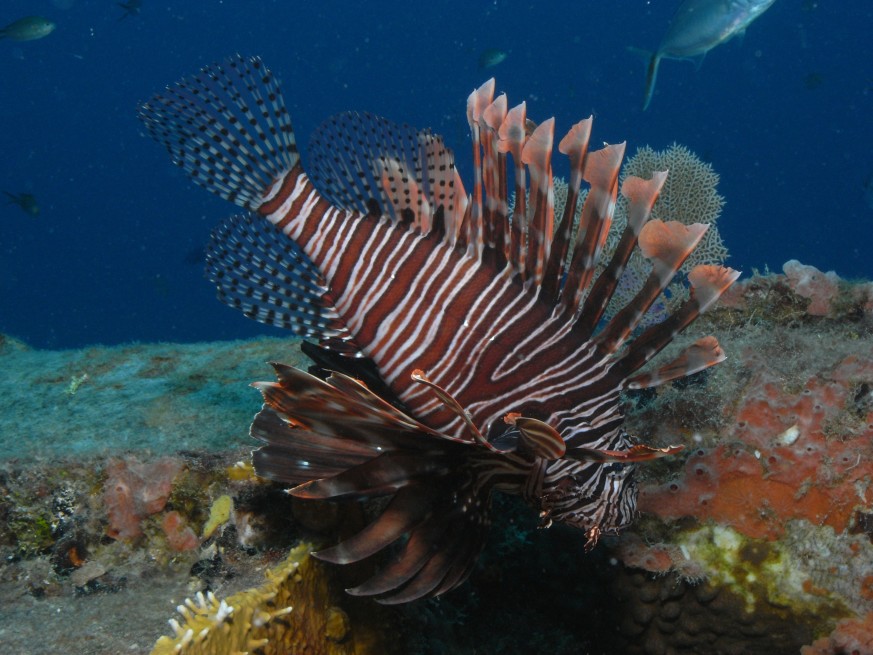Lionfish cuba
Common Names: lionfish, zebrafish, firefish, turkeyfish, red lion fish, butterfly cod, ornate butterfly-cod, peacock lionfish, red firefish, scorpion volitans, devil firefish
Habitat: Lionfish are found in mostly all marine habitat types found in warm marine waters of the tropics. Lionfish cuba have been found in water depths from 1 to 300 feet on hard bottom, mangrove, seagrass, coral, and artificial reefs (like shipwrecks).
They have been spotted in water as little as 1 foot (.3m) deep to beyond 1,000 feet (305m) deep. They are equally at home in brackish water river estuaries and mangroves, where most of the juvenile fish grow up. Being able to tolerate water temperatures down to 50 degrees Fahrenheit (10 degrees Celsius) they have established a current range from Rhode Island, United States as far south as Brazil. They are highly tolerant to temperature change and biologically resistant to most diseases and parasites that affect native fish. When food is scarce due to temperature and climate, lion fish can live beyond 3 months without eating anything at all and lose very little body mass as a result.
Lion fish can live in excess of 15 years and have no natural predators in the Western Atlantic Ocean, Caribbean Sea or Gulf of Mexico that are capable of controlling the burgeoning lion fish population.
We are only just beginning to understand the consequences of the lionfish Cuba invasion at this point, even the scientists that have been studying the non-native lion fish for two decades are having a really tough time even articulating what the landscape of our local oceans and seas are going to look like ten short years from now. The population explosion has taken most of them completely by surprise and they readily admit that the problem is far worse than could be imagined even six or seven years ago.
Behavior: Lionfish are thought to be nocturnal hunters, but they have been found with full stomachs during the day in the Atlantic. They move about by slowly undulating the soft rays of the dorsal and anal fins. During the day, they sometimes retreat to ledges and crevices among the rocks and corals. Although in the Atlantic, lion fish are often seen moving about during the day, both alone and in small groups.
How did the lionfish end up in Cuba’s waters in the first place?
It is speculated that the root of the problem was only 6 lionfish accidently released from an aquarium during hurricane Andrew in 1992. Genetic research supports this finger pointing but it is likely that many more have been intentionally released by “retired” aquarium enthusiasts. With no natural enemies and an extremely high reproductive rate of 2 million eggs a year from one female, unsurprisingly they’ve taken over rapidly (NOAA).
The cold water temperatures are keeping their numbers in check to the north, but this is not the case to the south where lionfish are spreading rapidly through the South Florida Estuaries, the Gulf of Mexico and the Caribbean Sea. Marine Scientists believe they will have established themselves as far south as Brazil within the next five to ten years.
Surveys conducted by Paula Whitfield and her team in 2004 found that lionfish were already as abundant as many native groupers, and second in abundance only to scamp (Mycteroperca phenax) (Whitfield et al, 2007). This is extremely concerning given the short time period for this population growth to occur. Recent estimates of lionfish densities show the populations continuing to grow, with the highest estimates reporting over 1,000 lionfish per acre in some locations (NOAA).
Lionfish now occupy an extensive geographic range, and are able to survive in a range of habitats and depths (2-140m). Lionfishes have now become established in Bermuda, the Bahamas, Columbia, Cuba, the Dominican Republic, Jamaica, Puerto Rico, Turks and Caicos, and the Cayman Islands. There are also reported sightings in Belize, Haiti, U.S. Virgin Islands, Mexico, and Aruba, Curacao, and Bonaire (NOAA).
Why are Lionfish a Problem?
Yes. Non-native lionfish are a terrible problem in the Western Atlantic Ocean, Caribbean Sea and in the Gulf of Mexico, however they are not a problem in their native ranges of the Indian Ocean, Southern and Western Pacific Ocean and in the Red Sea. The world is still waiting to see how bad the problem with non-native lionfish in the Mediterranean is going to get; it is a relatively “new” invasion that is only just really beginning to develop.
